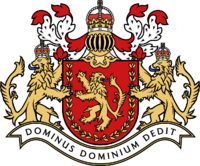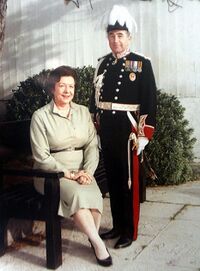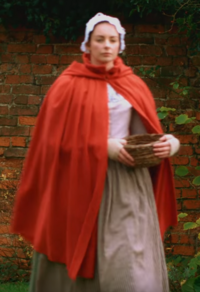Nortish dress codes
| Part of a series on the |
| Culture and Society of Great Nortend |
|---|
 |
Erbonian dress or Nortish dress refers to the forms of dress recognised and worn in Great Nortend. Nortish dress is a form of Western clothing; however, it has many distinct features and retains a unique appearance to the more homogenised modern Western forms of dress. In Erbonian society, there are three main dress codes with their own widely recognised forms of dress:— court dress, full dress and undress.
Court dress

Court dress is the most formal dress code and is worn at royal, state and official occasions such as royal courts, levées, balls, ceremonies, investitures, coronations, funerals and religious services, government and diplomatic occasions, as well as at the ceremonies of municipal, legal, academic and other 'dress' corporations.
The cloth court suit consists of a wool tailcoat with pidgeon-breasted lapels, a high standing collar and six silver buttons with matching buttonholes on the other side. It is cut small and cannot be closed. It is worn with matching breeches, white stockings, silver buckled court shoes, plain waistcoat, stiff bosom shirt, stiff standing collar, stiff single cuffs and a white bowed necktie. Common colours include claret, grey, brown, violet and green.
The velvet suit is worn during the evening. It is of swart silk velvet trimmed with silk and worn with a white silk waistcoat. Otherwise, it is the same as for the cloth suit.
Clerical court dress consists of a knee-length apron cassock with sash. In the evening, the apron is trimmed in silk.
Court uniform
Court uniform is worn by members of the Royal Army, the Navy Royal, the Civil Service and the Diplomatic Services on occasions demanding court dress. The various classes or ranks are denoted by increasing quantities of gold and silver embroidery, and in the case of military uniforms, by insignia. Court uniform generally buttons up fully with embroidery across the front. Officer cadets, ensigns, midshipmen and other ranks do not wear tails.
Full dress
Full dress is worn on formal non-state occasions. It is often worn at weddings, funerals, christenings, festal religious services, dinners at restaurants, operas, concerts, balls and the like. A number of people wear full dress regularly at dinner.
It consists of either a morning coat in various shades but often in grey or swart, or a evening coat in swart. Both are cut identically, with pointed lapels in cloth for morning and in silk for evening. Both morning and evenings coats are worn with a stiff bosom shirt, stiff standing collar and stiff single cuffs.
The morning coat is normally worn with a long tie, pastel waistcoat, grey striped or chequered trousers, and black dress boots. The evening coat is worn with a bowed tie, either white or black, a white or black waistcoat, plain or striped swart trousers with a double stripe of silk tape, and black evening shoes.
Undress
Undress dress for civilians consists of day town dress and evening lounge dress. Town dress is worn in “town” and in the country on more formal occasions such as at church, luncheons &c. It consists of a cloth suit of coat, waistcoat and trousers, usually worn with a soft shirt, stiff turned collar and long tie. More formal town dress has a swart coat and grey striped or chequered trousers, colloquially known as a “round suit”.
The “lounge suit” should not be confused with Nortish lounge dress, which consists of a casual “smoking” jacket and dinner trousers, usually worn with a soft shirt, stiff collar and bowed tie.
Country habit
The costume habits worn in the countryside of Great Nortend vary between localities and class but generally are of the same simple form. Local differences mostly manifest in fabric, patterns, colours, cut and headdress of formal habits. For ordinary day-to-day wear, country habit in adapted form is still common.
Men
Male country habit is fairly uniform. It consists of a collared shirt with stiff collar closed with a woollen or silken long tie. Over the shirt, men wear a woollen coat which is usually single breasted with notched labels. It often has a contrasting collar in corduroy or felt. A waistcoat, in brightly coloured wool, is worn under the coat.
Legwear consists of trousers or sometimes, breeches, both held up by braces. Woollen stockings are worn with garters. Leather boots or sometimes wooden soled clogs with laced leather uppers are worn. A woollen flat cap, a bonnet or a felt hat is worn as headdress, or a straw hat in the summer.
Women
Female country habit is more diverse in style. Broadly, women wear a pair of stays over the chemise to support the chest and to give the desired shape. A collared blouse may or may not be worn. Women over their chemise and stays wear a short-gown which is a form of bodice, often with sleeves, either attached or separate. An apron or shawl may be worn depending on local custom and occasion.
Women wear a number of petticoats. These are around ankle length, although they tend to be around mid-calf length in the warmer South. Over the petticoats a woollen skirt is worn. Woollen stockings are worn with garters. As with men, leather boots or wooden soled clogs with leather uppers are common, although women usually have buckles instead of laces.
A linen cap covering the hair, and a woollen or felt bonnet or hat is worn by women or in summer, a straw hat. There are a large variety of traditional headdresses for more formal occasions, often unique to specific villages or regions.
This page is written in Erbonian English, which has its own spelling conventions (colour, travelled, centre, realise, instal, sobre, shew, artefact), and some terms that are used in it may be different or absent from other varieties of English. |



